OEM Laser Modules
Definition: laser modules made for integration into larger devices by another manufacturer
More specific term: laser diodes modules
German: OEM-Lasermodule
How to cite the article; suggest additional literature
Author: Dr. Rüdiger Paschotta
Industrial lasers are not necessarily sold as complete laser systems, but often in the form of OEM laser modules. That means that an original equipment manufacturer (OEM) supplies lasers to one or more other manufacturers who integrate them into larger machines, for example for laser material processing. Each company can then concentrate on its own areas of responsibility, without a necessity to completely understand the whole system. In particular, it should normally not be necessary that the integrator understands the details of the inner workings of an OEM module.
OEM laser modules can contain laser diodes, lamp-pumped lasers, diode-pumped solid-state lasers, gas lasers or (less frequently) other types of lasers. Additional optical elements for beam shaping and possibly for nonlinear frequency conversion may be included in the housing. For example, there are green laser modules, generating laser beams at the common 532-nm wavelength (frequency-doubled Nd:YAG). The light output may be provided as a free-space laser beam alternatively through an optical fiber.
Often, but not always, an OEM laser has its own complete enclosure, even if the device is to be integrated in a larger product with an own closed housing. That further supports the separation of responsibilities between laser manufacturer and system integrator.
Special Aspects of OEM Lasers
The requirements on OEM lasers are basically the same as for other lasers. However, optical, mechanical and electronic interfaces should be particularly carefully designed for easy integration into a larger system. For example, it needs to be defined what are the spatial properties of the generated laser beam (focus position, beam radius, beam quality), what electrical voltage and power requirements the laser has, how exactly laser pulses can be triggered, and how the module is supposed to be fixed on a base plate. There may be further details concerning the dissipation of waste heat – for example, the allowed temperature of the base plate and the maximum dissipated power.
A OEM laser is often not powered directly by the electrical grid, but is provided with one or more lower stabilized voltages from the power supply of the full system. Ideally, only a single voltage at a standard voltage level is required, and the module contains protective electronics to make the model robust against voltage spikes and drifts.
An OEM laser should after its production not require special alignment procedures, for example, since one prefers to avoid that the integrator has to deal with such issues.
Compatibility of Models from Different Suppliers
A system integrator often prefers to have at least two different suppliers (manufacturers) for certain laser modules in order to avoid a too strong dependence on a single supplier and its reliability. Of course, this requires again that the optical, mechanical and electronic interfaces are well defined and that they agree between the different manufacturers. Otherwise, the system may have to be modified when integrating a different kind of module. Best compatibility is often achieved for fiber-coupled modules.
Suppliers
The RP Photonics Buyer's Guide contains 19 suppliers for OEM laser modules. Among them:
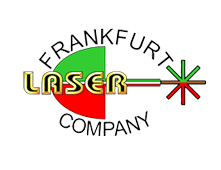

Frankfurt Laser Company
FLC laser diode modules are easy to use plug and play laser systems suitable for a wide range of military, industrial and medical applications.
Suited for pointing and target designation, spectroscopy, measurement equipment, laser display, printing, biomedical, patient positioning, material processing, laser show, alignment and positioning of materials including garments, cloth, paper, wood, stone and metal.

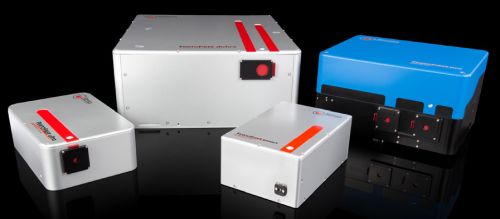
TOPTICA Photonics
TOPTICA supports multiple product lines and philosophies for different customer applications. For OEM integration the compact and single purpose smart product line has been developed. TOPTICA's single-mode diode lasers combine excellent diode technology and rock-solid opto-mechanical engineering with convenient computer-control and intelligent protection measures. The single-frequency diode lasers employ state-of-the-art diode technology to achieve the highest single-frequency output power of any direct diode-based system. Our ultrafast fiber laser systems are dedicated to applications ranging from seed laser purposes, biophotonics to terahertz generation and two-photon polymerization.

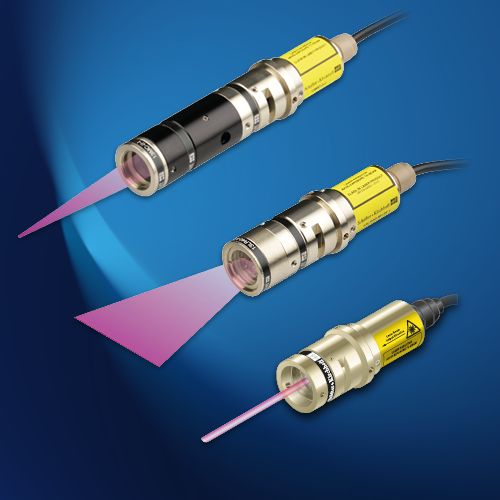
Schäfter + Kirchhoff
Schäfter+Kirchhoff offer various laser line generators, laser focus generators or laser diode collimators. You can select them easily using our product configurator.
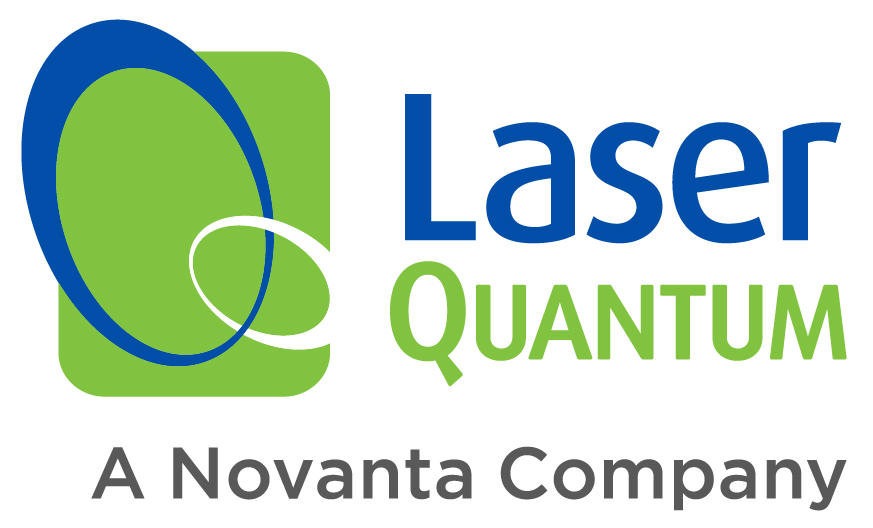
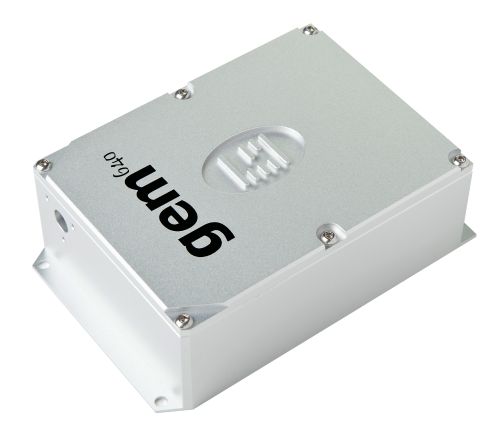
Laser Quantum
The Laser Quantum gem family offers multiple wavelengths: 473, 532, 561 and 640 nm, amongst others, to excite a variety of fluorophores. It features high output power, M2 close to unity and supports direct fibre coupling solutions.
The opus, available in 532, 660 and 1064 nm, with its rugged, patented design, is characterised by its high power and compact size. It is suitable for military-graded applications and also ideal in the fields of biomedicine, super-resolution microscopy and Ti:sapphire pumping.
The axiom laser family has a new integrated water cooling architecture for high CW power. With a 660 and 532 nm version, the axiom lends itself to easy integration into equipment due to its ultra-compact power supply unit, without the complexities associated with fibre delivery.
The torus family contains single longitudinal mode lasers with bandwidths below 1 MHz. These are ideal for applications such as high resolution Raman spectroscopy, holography and interferometry that benefit from the long coherence length. The torus also supports TruLoQ™ active mode locking technology. It offers a narrow linewidth, avoiding mode drift and mode hops.


Lumibird
Lumibird manufactures an extensive range of mature and custom-designed optical fiber amplifiers. Our CW models are used for atom cooling, free space communication or optical remote sensing etc., while our pulsed models are used for applications such as high peak power generation or wind sensing LiDAR. Lumibird also manufactures diode-pumped solid-state laser heads used as optical amplifiers.


Fluence
Our 1030-nm industry-grade femtosecond oscillator is not a usual laser – this is the superhero of laser oscillators. It has special superpowers that make it stand out from the crowd. Super-short yet ultra-fast. Small in size but very stable and robust. The earth may tremble but the laser will operate as usual. Same power, same pulse and no degradation over many years.
This oscillator was specifically developed to be the rock-solid heart of the Fluence Jasper amplified system. It is build upon the Fluence truly-all-fibre technology, with no degradable components inside. The oscillator is equipped with a special self-starting solution ensuring the laser mode-locks every time. This feature together with the low size and power consumption makes the Fluence oscillator perfect for OEM applications.


Menlo Systems
Menlo Systems' compact OEM laser modules are based on Menlo figure 9® patented laser technology and are unique in regard to user-friendliness and robustness to ensure 24/7 operation. Our ELMO and YLMO series guarantee lowest amplitude and phase noise for seeding applications, spectroscopy, or quality control. Our BlueCut laser with microjoule pulse energy and programmable pulse burst mode is ideal for material processing, ophthalmology, or high-resolution microscopy. With optionally available frequency conversion our OEM modules cover a wide wavelength range.
Questions and Comments from Users
Here you can submit questions and comments. As far as they get accepted by the author, they will appear above this paragraph together with the author’s answer. The author will decide on acceptance based on certain criteria. Essentially, the issue must be of sufficiently broad interest.
Please do not enter personal data here; we would otherwise delete it soon. (See also our privacy declaration.) If you wish to receive personal feedback or consultancy from the author, please contact him e.g. via e-mail.
By submitting the information, you give your consent to the potential publication of your inputs on our website according to our rules. (If you later retract your consent, we will delete those inputs.) As your inputs are first reviewed by the author, they may be published with some delay.
See also: lasers, industrial lasers
and other articles in the category lasers
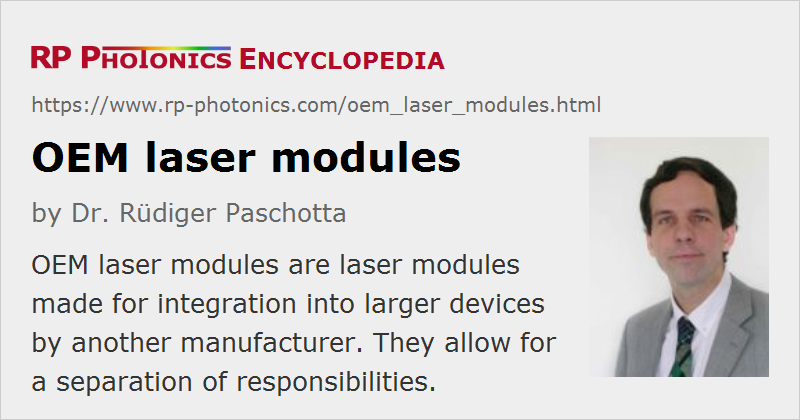 |



If you like this page, please share the link with your friends and colleagues, e.g. via social media:
These sharing buttons are implemented in a privacy-friendly way!